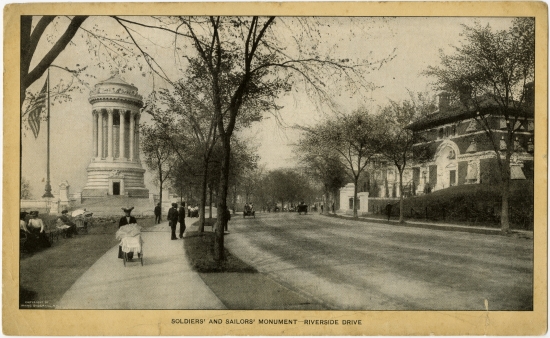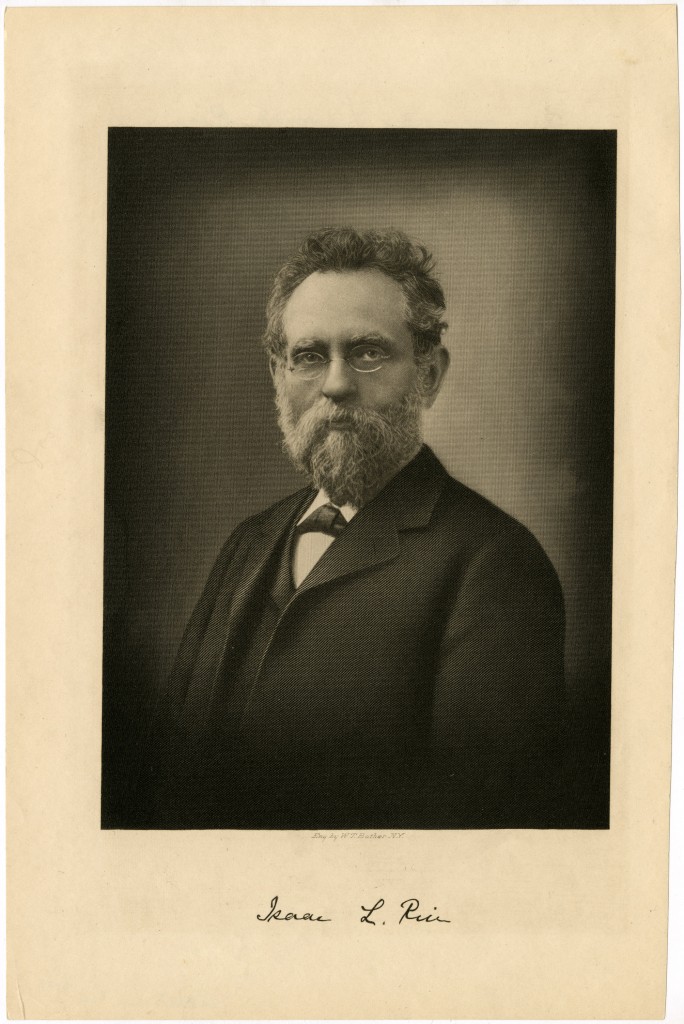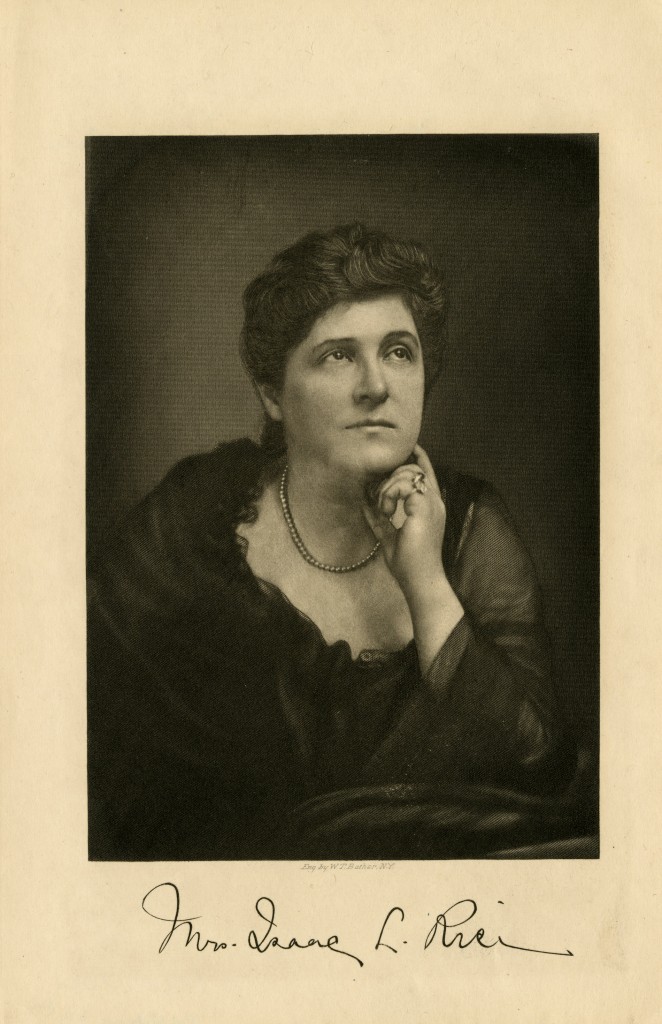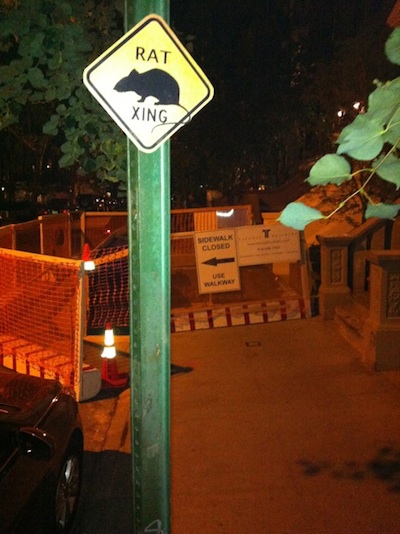In our History Beat series, we choose an object or document from the New-York Historical Society Library’s collection that relates to the history of the Upper West Side and use it as the focus of an article. The topic for this month’s column is the Rice Mansion on 89th Street and Riverside Drive.
When I started to research the Rice Mansion at 89th Street and Riverside Drive, it was the bricks and mortar that drew me to it. I was seduced by the looks of such a beautiful old mansion, one of only two that remain standing as a reminder of the glory days of Riverside Drive. At the turn of the 20th century there were 135 single-family homes along the Drive. Most were row houses but 30 or so were free-standing structures, bordering on the drive and park that had been planned by Frederick Law Olmsted in 1873 and completed in 1898.
As I looked into the history of the mansion, I uncovered the story behind the bricks, the story of the incredible man who had the mansion built, his accomplished wife and his six children. As is often the case, personality trumped architecture.
In 1899 Isaac L. Rice purchased the land for his mansion from William W. Hall, a well-known builder and real estate developer who was active on both the East and West sides of the city. This was the same year that the site for the Soldiers and Sailors Monument, just across the Drive from the Rice Mansion, had been chosen.

In this image from 1899, the Rice Mansion is on the right and the Soldiers’ and Sailors’ Monument is on the left. This was from a palm card advertising Singer Sewing Machines.
According to a covenant made in 1898 between Hall and Benjamin Altman (of B. Altman fame) who owned the property at 88th and Riverside, the parcel of land that Rice purchased had to be “a high class private dwelling house, not less than four stories, and designed for the use of one family only.”
Rice chose the architectural firm of Herts and Tallant, two Beaux-Arts trained architects who were just starting their careers. Henry Herts and Hugh Tallant met while they were students in Paris and when they returned home they began their partnership by designing an extension to the Harmonie Club—an exclusive German-Jewish club to which Rice belonged. Herts and Tallant were best known for their theater designs which included the New Amsterdam, the Gaiety, the Folies Bergere (now the Helen Hayes) the Longacre and the Brooklyn Academy of Music.
In compliance with the Altman/Hall covenant, Herts and Tallant designed a four story house faced with red brick laid up in Flemish bond style (an arrangement of bricks with alternate bricks having short sides and long sides facing outwards) with contrasting marble detail. According to the Landmarks Preservation Commission report (the mansion was landmarked in 1980) the building is reminiscent of the popular neo-Georgian style of the period with other elements strongly reflecting the traditions of the Beaux Arts design that the architects studied first hand in Paris. “The total effect is highly individualistic and not readily classified by stylistic terms” according to the author of the report, Marjorie Pearson. The house sits majestically facing the park with the main entrance at the second floor level surrounded by an arch that rises to the third story–an especially grand entrance for a private home. On the 89th Street side of the house at ground level is a porte-cochere that was probably included as a place for Rice to park one of his beloved motor cars.
The mansion as you see it now has had some changes over the years. The first were made by Solomon Schinasi, an importer of Turkish tobacco, who bought the mansion in 1907 after the Rice family suffered a financial set back. Fortunately, the Schinasi changes are not that visible from the street and when you look at the mansion, you are seeing much of what early 20th century New Yorkers saw when they strolled past the house.
Interestingly, it was Schinasi’s brother, Morris, who built his own free-standing mansion just up the Drive at 351, between 107th and 108th Streets, that is the only other mansion to survive on the Drive. The Schinasi family lived in the Rice house until 1945 when it was leased to the Hekscher Foundation for Children. The trustees of the estate of Leon Schinasi sold the mansion to Yeshiva Chofetz Chaim in 1954 which continues to operate it as an elementary school.
But that is now. Let’s go back to then and to how Isaac B. Rice came to build his family this exquisite home.
 Isaac came to the United States with his family in 1856 at the age of 6 from Bavaria. The family settled in Philadelphia where Isaac studied in public schools and with private tutors. At the age of 16 he went off to Paris to study literature and music. While in Paris he acted as a correspondent for the Philadelphia Evening Bulletin. He taught music and languages in London and in 1869, returned to the U.S., this time to New York, where he taught music and continued his writing. In 1875 he wrote a well-received scientific study entitled “What is Music” and three years later he entered Columbia University Law School, graduating in 1880 with prizes in constitutional and international law. He taught at Columbia as a lecturer in the School of Political Science and at the Law School. At the same time, he maintained a private practice and became an attorney for the Brooklyn Elevated Railroad. Before long he became counsel to several railroads and soon made his fortune with the Philadelphia and Reading Railroad. An early fan of electrical inventions, he became president of a number of electricity-related enterprises, including the Electric Boat Company.
Isaac came to the United States with his family in 1856 at the age of 6 from Bavaria. The family settled in Philadelphia where Isaac studied in public schools and with private tutors. At the age of 16 he went off to Paris to study literature and music. While in Paris he acted as a correspondent for the Philadelphia Evening Bulletin. He taught music and languages in London and in 1869, returned to the U.S., this time to New York, where he taught music and continued his writing. In 1875 he wrote a well-received scientific study entitled “What is Music” and three years later he entered Columbia University Law School, graduating in 1880 with prizes in constitutional and international law. He taught at Columbia as a lecturer in the School of Political Science and at the Law School. At the same time, he maintained a private practice and became an attorney for the Brooklyn Elevated Railroad. Before long he became counsel to several railroads and soon made his fortune with the Philadelphia and Reading Railroad. An early fan of electrical inventions, he became president of a number of electricity-related enterprises, including the Electric Boat Company.
But Rice was not just about business. He continued his literary career by establishing The Forum, a well-respected political review. And he was an avid chess player who invented the “Rice gambit.” It is said that his first law client came to him after a chess match, impressed with Rice’s great skill at the game. Rice’s enthusiasm for chess—he was the umpire of all international chess games played by cable—is reflected in his mansion, where he had a chess room hewn out of solid rock in the basement and accessible by elevator.
In the money panic of 1907, Rice’s holdings were swept away, except for his stock in the Electric Boat Company which was non-productive at the time. This was when he was forced to sell his beloved mansion. But, in 1913, when Great Britain placed orders for submarines at Electric Boat, Rice’s shares sky-rocketed and his fortunes reversed dramatically—he sold his 16,000 shares for a profit of 2 million dollars. (If he had waited three months longer, it would have been 16 million).
Rice died at his apartments at the Hotel Ansonia, not far from his mansion, in 1915.
 And then there is the woman Isaac married in 1885, Julia Barnett Rice, a remarkable person in her own right. Rice named their mansion Villa Julia in honor of this woman who matched her husband in both intelligence and accomplishment. Born in New Orleans where she received a classical education, she moved to New York to attend the Woman’s Medical College of the New York Infirmary where she graduated as an M.D. She never practiced medicine but worked alongside her husband on the literary journal The Forum and contributed essays to other literary magazines of the time.
And then there is the woman Isaac married in 1885, Julia Barnett Rice, a remarkable person in her own right. Rice named their mansion Villa Julia in honor of this woman who matched her husband in both intelligence and accomplishment. Born in New Orleans where she received a classical education, she moved to New York to attend the Woman’s Medical College of the New York Infirmary where she graduated as an M.D. She never practiced medicine but worked alongside her husband on the literary journal The Forum and contributed essays to other literary magazines of the time.
What Julia Rice is best remembered for is her establishment of the Society for the Suppression of Unnecessary Noise, the earliest anti-noise pollution movement in the U.S. From her perch on Riverside Drive, overlooking the Hudson River, Julia became enraged about the din of the tugboat horns on the river. She engaged a group of Columbia students—probably her husband’s students—to take a sound survey and discovered that on any typical night the tugs would toot 2 to 3 thousand times! Julia declared war on the noise and went to police stations, the health department, offices of shipping regulators and finally to Congress until she won her battle. Encouraged by her victory, she went on to promote quiet zones around hospitals and, backed by Mark Twain, convinced school children to pledge to keep quiet while walking or playing near hospitals.
When her husband died, Julia financed two New York philanthropic projects in his memory, both designed by the architects who had designed her magnificent home: The Betsy Head Memorial Playground in the Brownsville section of Brooklyn — a neighborhood with many Jewish immigrants — and the Isaac L. Rice Playfield in Pelham Bay Park.
The National Encyclopedia of American Biography, published in 1901, described Isaac Rice as “a man of extraordinary gifts with a mind similarly alert and comprehensive, with indomitable energy and perseverance.” Clearly, the same could be said of Julia. It is a fitting tribute to these two outstanding New Yorkers that their lovely mansion, although somewhat altered, still bears witness to the time when Riverside Drive first became home to some of the most interesting and influential New Yorkers of the 20th century.
All photos courtesy of the New-York Historical Society.
To read the other articles in this series, click here.










I remember they wanted to knock this down and build a highrise. It must have been in the early 80s.
I haven’t walked by it recently but I do remember in r3ecent years the building being a filthy falling apart mess.. with big huge ugly plastic childrens’ toys outside.
Beautiful building, I wish the Yeshiva kept it up a little better! It’s oftentimes looked abandoned — doors chained up, etc.
How great to have our neighborhood’s history come alive in this series of articles. Perhaps it’s time to revive the Society for the Supperession of Unnecessary Noise in memory of the fascinating Julia Rice.
Very nice in-depth treatment of an amazing couple. You might have added that Isaac Rice’s Electric Boat Company, like his Riverside Drive mansion, lives on to this day as General Dynamics, the world’s fourth-largest defense contractor. For the tugboat operators’ response to Julia Rice’s “meddling” with their business, see chapter 5 of “Upper West Side Story,” my book on the neighborhood & it’s curious history.
Yes, indeed.
Very interesting! I always wondered about that mansion on Riverside Drive. I, too, wish the Yeshiva took better care of the place.
I’ve walked by this mansion so many times and wondered about its history. What a great description not just of the building but of the amazing couple who lived there.
Delightful piece. Interesting story about the family. So glad the mansion still stands as a reminder of the old Upper West Side. Julia Rice, thou should’st be living at this hour… The honking of horns and the still occasional car alarm would send her to apoplexy. We obviously owe what peace and quiet we have to her!
Loved the Rice story. Can’t wait for S.H. To show up.
(NYC…..small world: one of my lawfirm’s first major clients was the Electric Boat Company.)
You may be interested in reading my book Making Noise: From Babel to the Big Bang and Beyond, Zone, 2011, which devotes more than fifty pages to Julie and Isaac Rice and supplies far more context and many more personal details about both of them, including the architecture of the mansion…
What a great NYC story. Riverside Drive is one of my favorite streets in all NYC. I know this Mansion well, as I lived for many years at 11 Riverside Drive, which was where the Charles Schwab Mansion originally stood. In the winter time the wind from across the Hudson is so strong, it can practically knock you over.
Julia and Isaac Rice were my great grandparents. Their six children were comprised of two boys and four girls. The girls were nicknamed Dolly, Polly, Molly, and Lolly. My grandmother was Lolly, the youngest of the daughters. The six children were quite interesting in their own right! Visited the house when I was very very young. Would love to see it again. Thank you for this article.
I would very much like to talk with you
and you would likely very much like to read my book, Making Noise: From Babel to the Big Bang and Beyond (NY: Zone and MIT, 2011, pages 484-538 on the Rice family, which goes well beyond what is written here, and for which I also left out much material that I had gathered. There were however gaps in my research that you no doubt could help fill in.
Hillel Schwartz 760-436-7748
I would very much like to talk with you
and you would likely very much like to read my book, Making Noise: From Babel to the Big Bang and Beyond (NY: Zone and MIT, 2011, pages 484-538 on the Rice family, which goes well beyond what is written here, and for which I also left out much material that I had gathered. There were however gaps in my research that you no doubt could help fill in.
Hillel Schwartz 760-436-7748
Margie, I would love to hear more about your grandmother and her five siblings. Your family is a fascinating part of Upper West Side history and the readers of this website are your ideal audience! Please elaborate if you’re so inclined.
My grandfather married Dorothy “Dolly”, author of “Curiouser and Curiouser”. I’m trying to assemble a geneology on https://www.geni.com. Look up Isaac Rice.
see my response below to Margie
Don’t know if you are willing to correspond with me but I have a novel coming out soon which I barely have time to make more changes in. The novel opens into an Edith Wharton-like world in a Mansion on the upper west side in the 1880-90s. I think the description of the Rice Mansion would fit perfectly, and I’d like to use some more detail. Would you be interested to correspond/chat so I could learn a little more about it and some history of the UWS from you? I’d be willing to share the chapter after we’ve spoken.
Thanks so much,
Rip Brown
Boy! You hit the nail on the head. You did leave out a lot I think you would be fascinated by like Julia’s fight with the city over Rice stadium, the taxi companies, etc. Thank you for your insightful article and if this even reaches you please contact me. I am Isaac’s Great Grandson and you have no idea of the surface you just scratched.
TC Rice
646 244 5597 feel free to call.
See my response above to Margie